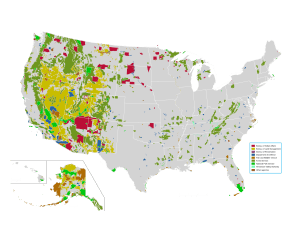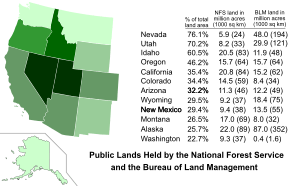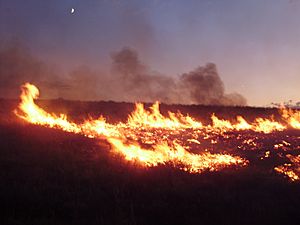Bureau of Land Management facts for kids

Bureau of Land Management Triangle
|
|

Flag of the Bureau of Land Management
|
|
| Agency overview | |
|---|---|
| Formed | December 10, 1946 |
| Preceding agencies |
|
| Jurisdiction | United States federal government |
| Headquarters | 1849 C Street NW, Washington, D.C. 20240 |
| Employees | Over 10,000 |
| Annual budget | $1.31 billion (FY2021) |
| Agency executive |
|
| Parent agency | U.S. Department of the Interior |
| Website | blm.gov |
The Bureau of Land Management (BLM) is a government agency in the United States. It is part of the United States Department of the Interior. The BLM is in charge of managing huge areas of U.S. federal lands. These are lands owned by the public.
The BLM's main office is in Washington, D.C.. It looks after more than 247 million acres (about 1 million square kilometers) of land. This is like one-eighth of all the land in the United States! Most of these lands are in 12 western states. These include Alaska, Arizona, California, Colorado, Idaho, Montana, Nevada, New Mexico, Oregon, Utah, Washington, and Wyoming.
President Harry S. Truman created the BLM in 1946. He combined two older agencies: the General Land Office and the Grazing Service. The BLM also manages the rights to minerals found deep underground. This includes minerals under federal, state, and even private lands.
The BLM's goal is to keep public lands healthy and diverse. They want these lands to be useful and enjoyable for everyone, now and in the future. At first, these lands were called "land nobody wanted." But today, they are very important. Ranchers use about 155 million acres for livestock grazing. The BLM also protects many special places. These include 221 wilderness areas and 29 national monuments. These are part of the National Conservation Lands. This system also includes nearly 2,400 miles of Wild and Scenic Rivers. There are also almost 6,000 miles of National Scenic and Historic Trails.
These lands are also important for energy. There are over 63,000 oil and gas wells on BLM lands. In 2013, energy leases brought in about $5.4 billion. This money was shared with the U.S. Treasury, states, and Native American groups.
Contents
History of Public Lands
The story of the BLM began a long time ago. It started with laws like the Land Ordinance of 1785. These laws helped survey and settle lands that the first Thirteen Colonies gave to the new U.S. government. This happened after the American Revolution. As the U.S. gained more land from other countries, Congress wanted these lands explored and settled.
In 1812, the General Land Office was created. It was part of the Treasury Department. Its job was to manage these federal lands. Over time, more laws were made to give away federal land. This included laws for soldiers and for people to start farms. Local land offices were set up across the country. They helped people get ownership of surveyed land.
In the early 1900s, Congress started to see the value of these public lands. They wanted the government to manage them better. The Mineral Leasing Act of 1920 allowed companies to lease public lands. They could explore and produce things like coal, oil, and gas. The Taylor Grazing Act of 1934 created the United States Grazing Service. This service managed public rangelands for grazing animals.
In 1946, the Grazing Service and the General Land Office joined together. This created the Bureau of Land Management. The new agency slowly changed its focus. It moved from giving away land to managing and protecting it for the long term. Most of the BLM's work happens in the western states. This is because most federal lands, mining, and land sales are there.
In 1976, Congress passed the Federal Land Policy and Management Act. This law made the BLM's mission clearer. It said that public lands should stay public. It also said these lands should be managed for "multiple use." This means using the lands in ways that help people now and in the future. This includes things like recreation, conservation, and resource use.
In 1996, President Bill Clinton used a special law to create the Grand Staircase–Escalante National Monument in Utah. This was the first of many national monuments on BLM lands. It showed a new focus on protecting these special places. This led to the creation of the BLM's National Landscape Conservation System in 2000.
More recently, under the Trump administration, the BLM offered many acres for energy development. This included oil, gas, and mining leases. The goal was to boost American energy. In 2020, the Great American Outdoors Act was signed into law. This law provides money from energy revenues to help maintain national parks and public lands.
Also in 2020, the BLM headquarters moved to Grand Junction, Colorado. This move was supported by some, but others worried it would make the agency weaker. Many experienced staff left because of the move. In 2021, the headquarters moved back to Washington, D.C.
Under the Biden administration, the BLM is trying new ways to manage grazing. They want to see if cattle grazing can also help conservation efforts. In 2022, the BLM bought over 40,000 acres of land in Colorado and Wyoming. This made more public land available for everyone to enjoy.
What the BLM Does
The BLM has many important jobs. Here are some of them:
- Grazing. The BLM manages livestock grazing on about 155 million acres. They give permits to ranchers to graze their cattle and sheep. These permits usually last 10 years and can be renewed. The fee for grazing is set by a formula from Congress. It cannot go below $1.35 per animal per month. Grazing on BLM lands has decreased over the years.
- Mining. The BLM oversees over 63,000 oil and gas wells on its lands. These wells provide 11 percent of the natural gas and 5 percent of the oil in the U.S. The BLM also issues permits for coal, minerals, and renewable energy projects. This includes wind, geothermal, and solar power.
- Coal Leases. The BLM manages coal rights on over 570 million acres. As of 2013, they had given out 309 leases for coal mining. This covers about 474,252 acres.
- Recreation. BLM lands offer many ways to have fun outdoors. There are thousands of miles of streams and rivers for fishing. There are also lakes and reservoirs for boating. The BLM manages over 4,500 miles of National Scenic, National Historic, and National Recreation Trails. These trails are used by hikers, bikers, and horseback riders. In 2013, over 61 million people visited BLM lands for recreation. Most BLM lands are open for hunting and fishing.
- Conservation. The BLM protects special lands through the National Landscape Conservation System. These lands are kept safe from development.
- Timberlands. The BLM manages 55 million acres of forests and woodlands. This includes areas where trees are harvested for wood.
- Firefighting. The BLM has over 3,000 firefighters. They work to put out wildfires on BLM-managed lands. In 2013, they fought 2,573 fires.
- Abandoned Mines. The BLM keeps a list of old, abandoned mines on its lands. As of 2014, there were nearly 46,000 such sites. The BLM works to clean up or manage the dangers from these old mines.
- Helium. The BLM runs the National Helium Reserve in Texas. This program started in 1925. The reserve stores helium, which is important for many uses.
- Revenue and Fees. The BLM brings in a lot of money for the U.S. government. In 2009, public lands were expected to make $6.2 billion. Most of this came from energy development. About 43.5% of this money goes to states and counties. It helps pay for roads, schools, and other community needs.
National Landscape Conservation System
The National Landscape Conservation System was created in 2000. The BLM oversees this system. These lands make up about 12% of all lands managed by the BLM. In 2009, Congress made this system a permanent part of public land protection. This means these places are protected for future generations. They are similar to national parks and wildlife refuges.
| Category | Unit type | Number | BLM acres | BLM miles |
|---|---|---|---|---|
| National Conservation Lands | National Monuments | 29 | 5,590,135 acres (22,622.47 km2) | |
| National Conservation Lands | National Conservation Areas | 16 | 3,671,519 acres (14,858.11 km2) | |
| Wilderness | Wilderness Areas | 221 | 8,711,938 acres (35,255.96 km2) | |
| National Wild and Scenic Rivers | National Wild and Scenic Rivers | 69 | 1,001,353 acres (4,052.33 km2) | 2,423 miles (3,899 km) |
| National Trails System | National Historic Trails | 13 | 5,078 miles (8,172 km) | |
| National Trails System | National Scenic Trails | 5 | 683 miles (1,099 km) | |
| Totals | 877 | About 36 million acres (150,000 km2) (some units overlap) | 8,184 miles (13,171 km) |
Source: BLM Resources and Statistics
Law Enforcement and Security
The BLM has its own law enforcement team. This team works to keep BLM lands and resources safe. BLM law enforcement rangers and special agents are trained at federal centers. There are almost 300 full-time staff in these roles.
Uniformed rangers make sure laws are followed on BLM lands. They carry firearms and defensive gear. They can make arrests and investigate crimes. Their main goal is to protect natural and cultural resources. They also protect other BLM employees and visitors. These rangers use many tools, like dogs, helicopters, and snowmobiles. This helps them cover the vast public lands.
BLM special agents are like criminal investigators. They look into serious crimes on BLM lands. They usually work in plain clothes. They carry hidden firearms and defensive gear. They conduct complex investigations and prepare cases for court.
Wild Horse and Burro Program
The BLM manages free-roaming horses and burros. These animals live on public lands in ten western states. Even though they are wild, the BLM must protect them. This is required by the Wild and Free-Roaming Horses and Burros Act of 1971.
Since these horses and burros have few natural predators, their numbers can grow very quickly. The law allows the BLM to remove extra animals. They can also offer animals for adoption.
The BLM has programs and partnerships to help manage these animals. There are several herds of horses and burros on 26.9 million acres of land. The BLM works to keep the animal populations healthy and balanced with the land. They partner with groups like the Mustang Heritage Foundation. These partnerships help with adoptions and educate people about wild horses and burros.
Renewable Energy

In 2009, the BLM created offices to help with renewable energy projects. These offices approve and oversee wind, solar, biomass, and geothermal projects. These projects are built on BLM-managed lands. The offices were set up in states with high interest in renewable energy. These states include Arizona, California, Nevada, and Wyoming.
- Solar Energy. In 2010, the BLM approved the first large-scale solar energy projects on public land. As of 2014, 70 solar projects were planned. They could cover 560,000 acres. The BLM has approved 29 projects that could create enough energy for about 2.6 million homes.
- Wind Energy. The BLM manages 20.6 million acres of public lands with wind potential. They have approved 39 wind energy projects. These projects can produce enough power for over 1.5 million homes.
- Geothermal Energy. The BLM manages 59 geothermal leases. These projects create 1,500 megawatts of power. This is over 40% of all geothermal energy in the United States.
- Biomass and Bioenergy. The BLM manages many timberlands. This means they have a lot of woody biomass. This biomass comes from smaller trees and wood left over from timber production. The BLM is working on projects to use this biomass for bioenergy.
See also
- Range Improvement Funds
- Rangeland management
- Sagebrush Rebellion







